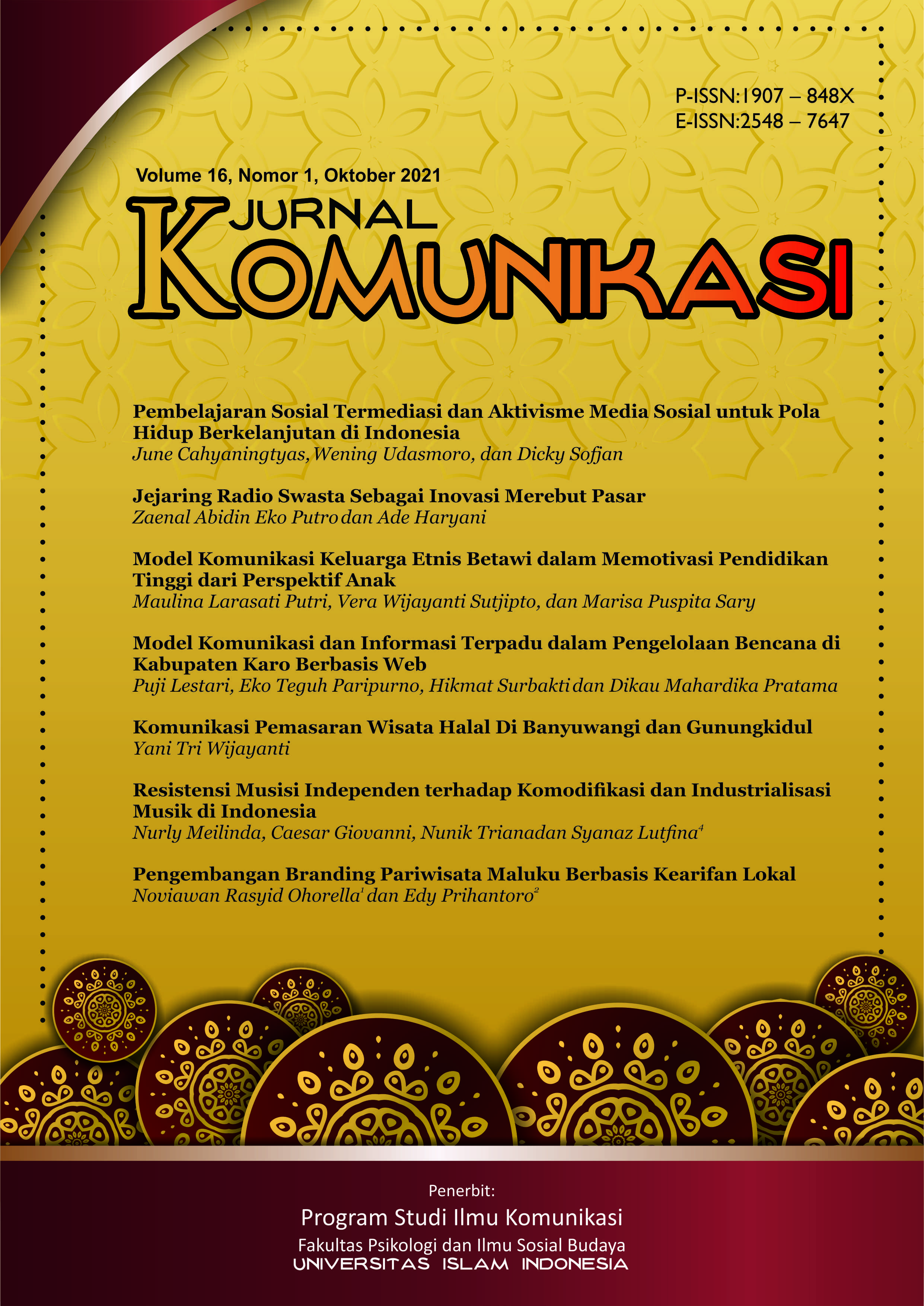Main Article Content
Abstract
The concept of Halal Tourism began to be adopted in Indonesia in 2014 and is getting stronger in Indonesia following the 2016 World Halal Tourism Award in Dubai. Several regions or districts responded to this by opening halal tourism, including Banyuwangi Regency and Gunungkidul Regency. Banyuwangi Regency launched tourist area branded as ‘the first sharia beach
tourism in Indonesia’, namely Santen Island Beach. Meanwhile, Gunungkidul Regency is on Torohudan Beach. The research method used is a case study. The discussion includes marketing strategy and marketing communication mix, showing the implementation of halal tourism management on Santen Island Beach was successful at the beginning with very strong branding evidence, marketing communication practices have maximized marketing strategy and communication mix. At Torohudan Beach, the community prefers the principle of ‘Muslim friendly tourism’, and in its implementation it needs support from the local government.
Keywords: branding, Halal Tourism, muslim friendly tourism, sharia beach tourism
Article Details
Authors who publish with this journal agree to the following terms:
- Authors retain copyright and grant the journal right of first publication with the work simultaneously licensed under a Creative Commons Attribution License that allows others to share the work with an acknowledgement of the work's authorship and initial publication in this journal.
- Authors are able to enter into separate, additional contractual arrangements for the non-exclusive distribution of the journal's published version of the work (e.g., post it to an institutional repository or publish it in a book), with an acknowledgement of its initial publication in this journal.
- Authors are permitted and encouraged to post their work online (e.g., in institutional repositories or on their website) prior to and during the submission process, as it can lead to productive exchanges, as well as earlier and greater citation of published work (See The Effect of Open Access).
References
- Battour, M. & Ismail, M.N. 2015. Halal Tourism; Concepts, Practices, Challenges, and Future. Tourism Management Perspectives. http://dx.doi.org/10.1016/j.tmp.2015.12.008.
- Chanin, O., Sriprasert, P., Rahman, H.A.M & Don, M.S. 2015. Guidelines on Halal Tourism Management in the Andaman Sea Coastof Thailand. Journal of Economics Business and Management. 3 (8). 791-794.
- COMCEC. 2016. Muslim Friendly Tourism: Understanding the Demand and Supply Sided in the OIC Member Countries. Turki
- Creswell, John W. (2014). Research Design: Pendekatan Kualitatif, Kuantitatif, dan Mixed. Yogyakarta: Pustaka Pelajar.
- Fatkurrohman. 2017. Developing Yogyakarta’s Halal Tourism Potential for Strengthening Islamic Economy in Indonesia. Jurnal Afkaruna. 13, 1-16.
- Haryanegara, M.E.A., Akbar, M.A.I, dan Novianti, Evi. 2021. Peran Label Pariwisata Halal Sebagai Daya Tarik Wisata Budaya di Lombok, Nusa Tenggara Barat. Tornare-Journal of Sustainable Tourism Research. Vol 3. No. 1, Januari 2021. 35-39.
- Kotler, Philip dan Keller, Kevin Lane. 2012. Manajemen Pemasaran jilid 2. Jakarta: Erlangga.
- Pratiwi, Soraya Ratna, Dida, Susanne. dan Sjafirah, Nuryah Asri. 2018. Strategi Komunikasi dalam Membangun Awareness Wisata Halal di Kota Bandung. Jurnal Kajian Komunikasi. Vol. 6. No. 1. Juni 2018. 78-90.
- Saufi, Akhmad., Mulyono, Edy Herman., dkk. 2020. Pariwisata Halal : Perlukah Rekonseptualisasi?.Jurnal Magister Manajemen Universitas Mataram.Vol 9-Issue 3-September 2020. 305-314.
- Shimp, Terrence A. 2003. Periklanan dan Promosi. Jakarta. Erlangga.
- https://www.banyuwangikab.go.id/pemerintahan/visi-dan-misi.html
References
Battour, M. & Ismail, M.N. 2015. Halal Tourism; Concepts, Practices, Challenges, and Future. Tourism Management Perspectives. http://dx.doi.org/10.1016/j.tmp.2015.12.008.
Chanin, O., Sriprasert, P., Rahman, H.A.M & Don, M.S. 2015. Guidelines on Halal Tourism Management in the Andaman Sea Coastof Thailand. Journal of Economics Business and Management. 3 (8). 791-794.
COMCEC. 2016. Muslim Friendly Tourism: Understanding the Demand and Supply Sided in the OIC Member Countries. Turki
Creswell, John W. (2014). Research Design: Pendekatan Kualitatif, Kuantitatif, dan Mixed. Yogyakarta: Pustaka Pelajar.
Fatkurrohman. 2017. Developing Yogyakarta’s Halal Tourism Potential for Strengthening Islamic Economy in Indonesia. Jurnal Afkaruna. 13, 1-16.
Haryanegara, M.E.A., Akbar, M.A.I, dan Novianti, Evi. 2021. Peran Label Pariwisata Halal Sebagai Daya Tarik Wisata Budaya di Lombok, Nusa Tenggara Barat. Tornare-Journal of Sustainable Tourism Research. Vol 3. No. 1, Januari 2021. 35-39.
Kotler, Philip dan Keller, Kevin Lane. 2012. Manajemen Pemasaran jilid 2. Jakarta: Erlangga.
Pratiwi, Soraya Ratna, Dida, Susanne. dan Sjafirah, Nuryah Asri. 2018. Strategi Komunikasi dalam Membangun Awareness Wisata Halal di Kota Bandung. Jurnal Kajian Komunikasi. Vol. 6. No. 1. Juni 2018. 78-90.
Saufi, Akhmad., Mulyono, Edy Herman., dkk. 2020. Pariwisata Halal : Perlukah Rekonseptualisasi?.Jurnal Magister Manajemen Universitas Mataram.Vol 9-Issue 3-September 2020. 305-314.
Shimp, Terrence A. 2003. Periklanan dan Promosi. Jakarta. Erlangga.
https://www.banyuwangikab.go.id/pemerintahan/visi-dan-misi.html




